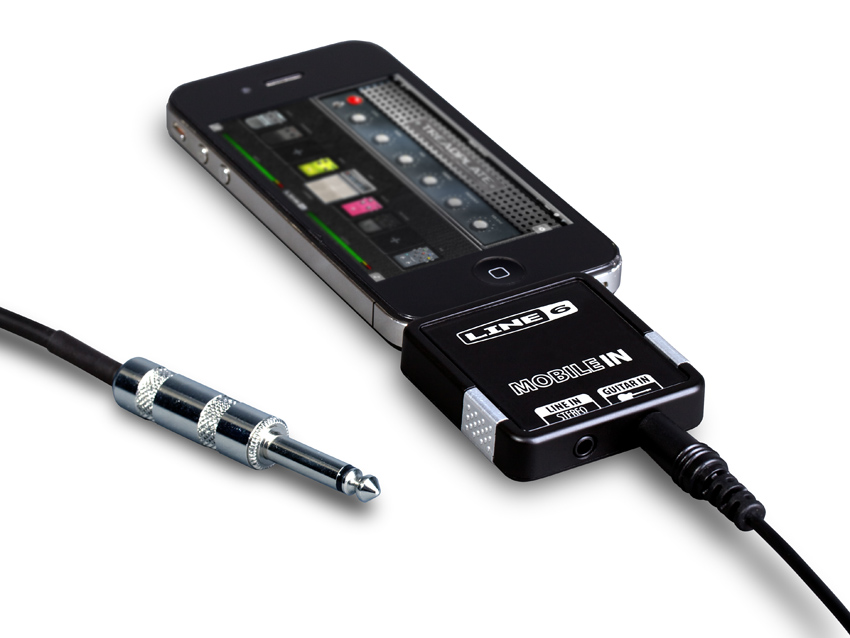Line 6 announces Mobile POD iOS app, Mobile In iOS guitar interface

Line 6 Mobile In

Line 6 Mobile In front

Line 6 Mobile In
Line 6 has a richer heritage than most when it comes to guitar amp and effects modeling, so it was only going to be a matter of time before it got itself involved in these areas of the iOS market (it's already done MIDI with the MIDI Mobilizer). As such, the announcements of the Mobile POD app and Mobile In guitar recording interface shouldn't come as any great surprise.
Mobile POD appears to be free, and offers "64 models of celebrated modern, vintage and boutique guitar gear including amps, cabinets, stompboxes and rack effects". These can be mixed and matched, and there are over 10,000 presets, apparently.
The Mobile In interface, meanwhile, differs from some of its rivals by connecting to the dock rather than the headphone socket of your iOS device. This means that it can operate at 24-bit/48 kHz, and also facilitates the addition of a stereo line input to sit alongside the guitar one.
Both software and hardware will be released in the Autumn - we'll bring you more on them both in due course. In the meantime, here's the official Line 6 press release.
Line 6 Mobile POD/Mobile In press release
Line 6, Inc. (line6.com), the industry leader in digital modelling technology for musicians, announced today Mobile In™ digital input adaptor and Mobile POD® guitar tone app. The new hardware and app allow guitarists to connect an electric guitar to their iPhone or iPad, which gives them the same high-quality sounds they'd get if they were playing from a wide variety of famous guitar amplifiers, speakers and effects including distortion, chorus and reverb.
"Mobile In and Mobile POD turn your iPhone or iPad into a fully functioning Line 6 POD multi-effect device complete with tweakable tones, simultaneous effects and legendary Line 6 guitar amp and effect modelling" remarked Line 6 Co-founder and SVP of New Business Development, Marcus Ryle. Line 6 pioneered digital modelling technology and, in 1998, released the first POD® multi-effect processor. This introduced countless guitarists to digital modelling, a technology that gives them access to wide varieties of amp and effect tones within one device. Ryle continues, "Mobile In is designed to be the best possible guitar tone solution for mobile devices. Other iOS guitar adaptors are rife with issues like headphone feedback, latency and poor sound quality. Mobile In solves all of these issues to deliver the best iOS guitar playing experience."
The new Mobile POD app brings famous Line 6 tone and technology to its most portable level. The free app includes generous collections of 64 models of celebrated modern, vintage and boutique guitar gear including amps, cabinets, stompboxes and rack effects. Users can mix and match the fully adjustable models to build a virtually unlimited variety of tones, which can then be saved as presets. Also included with the app, free of any in-app purchase, are over 10,000 hand-crafted presets created by artists, Line 6 and other guitar players.
Want all the hottest music and gear news, reviews, deals, features and more, direct to your inbox? Sign up here.
Unlike competing analogue adaptors that plug into an iOS device's headphone jack, Mobile In digital input plugs into the 30-pin connector on the bottom of the iOS device. This digital connection enables the adaptor to offer pro-quality audio specs for guitar tones that are exceptionally rich and clear. Mobile In supports up to 24-bit/48 kHz digital audio. The Guitar input features 110 dB dynamic range. The stereo Line input, which is perfect for sending keyboard audio or any other standard mono or stereo line-level audio source to your iPhone® or iPad®, has 98 dB dynamic range. Mobile In is the perfect digital input adaptor for use with any CoreAudio guitar apps including GarageBand® for iPad®.
Mobile In includes a high-quality 6-foot guitar cable. Mobile POD is a free download from the App StoreSM. Mobile In and Mobile POD are made for iPhone® 4, iPad® 2 and iPad®.
Learn more about Mobile In and Mobile POD at http://line6.com/mobilein
Mobile In and Mobile POD ship autumn 2011.

I’m the Deputy Editor of MusicRadar, having worked on the site since its launch in 2007. I previously spent eight years working on our sister magazine, Computer Music. I’ve been playing the piano, gigging in bands and failing to finish tracks at home for more than 30 years, 24 of which I’ve also spent writing about music and the ever-changing technology used to make it.